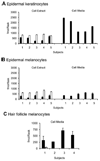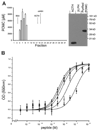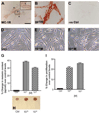Proopiomelanocortin (POMC), the ACTH/melanocortin precursor, is secreted by human epidermal keratinocytes and melanocytes and stimulates melanogenesis
- PMID: 17317724
- PMCID: PMC2253185
- DOI: 10.1096/fj.06-7398com
Proopiomelanocortin (POMC), the ACTH/melanocortin precursor, is secreted by human epidermal keratinocytes and melanocytes and stimulates melanogenesis
Abstract
Proopiomelanocortin (POMC) can be processed to ACTH and melanocortin peptides. However, processing is incomplete in some tissues, leading to POMC precursor release from cells. This study examined POMC processing in human skin and the effect of POMC on the melanocortin-1 receptor (MC-1R) and melanocyte regulation. POMC was secreted by both human epidermal keratinocytes (from 5 healthy donors) and matched epidermal melanocytes in culture. Much lower levels of alpha-MSH were secreted and only by the keratinocytes. Neither cell type released ACTH. Cell extracts contained significantly more ACTH than POMC, and alpha-MSH was detected only in keratinocytes. Nevertheless, the POMC processing components, prohormone convertases 1, 2 and regulatory protein 7B2, were detected in melanocytes and keratinocytes. In contrast, hair follicle melanocytes secreted both POMC and alpha-MSH, and this was enhanced in response to corticotrophin-releasing hormone (CRH) acting primarily through the CRH receptor 1. In cells stably transfected with the MC-1R, POMC stimulated cAMP, albeit with a lower potency than ACTH, alpha-MSH, and beta-MSH. POMC also increased melanogenesis and dendricity in human pigment cells. This release of POMC from skin cells and its functional activity at the MC-1R highlight the importance of POMC processing as a key regulatory event in the skin.
Figures






References
-
- Slominski A, Wortsman J, Luger T, Paus R, Solomon S. Corticotropin releasing hormone and proopiomelanocortin involvement in the cutaneous response to stress. Physiol. Rev. 2000;80:979–1020. - PubMed
-
- Pritchard LE, Turnbull AV, White A. Proopiomelanocortin processing in the hypothalamus: impact on melanocortin signalling and obesity. J. Endocrinol. 2002;172:411–421. - PubMed
-
- Pritchard LE, Oliver RL, McLoughlin JD, Birtles S, Lawrence CB, Turnbull AV, White A. Proopiomelanocortin-derived peptides in rat cerebrospinal fluid and hypothalamic extracts: evidence that secretion is regulated with respect to energy balance. Endocrinology. 2003;144:760–766. - PubMed
-
- Gibson S, Crosby SR, Stewart MF, Jennings AM, McCall E, White A. Differential release of proopiomelanocortin-derived peptides from the human pituitary: evidence from a panel of two-site immunoradiometric assays. J. Clin. Endocrinol. Metab. 1994;78:835–841. - PubMed
-
- White A, Gibson S. ACTH precursors: biological significance and clinical relevance. Clin. Endocrinol. (Oxford) 1998;48:251–255. - PubMed
Publication types
MeSH terms
Substances
Grants and funding
LinkOut - more resources
Full Text Sources
Miscellaneous

